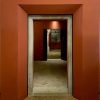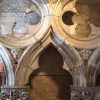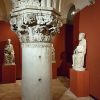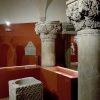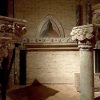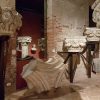Over the centuries, the Doge’s Palace has been restructured and restored countless times. Due to fires, structural failures and infiltrations on one hand, and new organizational requirements and modifications or complete overhaulings of the ornamental trappings on the other, there was hardly a moment in which come kind of works have not been under way at the building. From the Middle Ages the activities of maintenance and conservation were in the hands of a kind of “technical office”, which was in charge of all such operations and oversaw the workers and their sites: the Opera, or fabbriceria or procuratoria. After the mid-19th century, the Palace seemed to be in such a state of decay that its very survival was in question; thus from 1876 a major restoration plan was launched. The work involved the two facades and the capitals belonging to the ground-floor arcade and the upper loggia: 42 of these, which appeared to be in a specially dilapidated state, were removed and replaced by copies. The originals, some of which were masterpieces of Venetian sculpture of the 14th and 15th centuries, were placed, together with other sculptures from the facades, in an area specifically set aside for this purpose: the Museo dell’Opera. After undergoing thorough and careful restoration works, they are now exhibited, on their original columns, in these 6 rooms of the museum, which are traversed by an ancient wall in great blocks of stone, a remnant of an earlier version of the Palace. The rooms also contain fragments of statues and important architectural and decorative works in stone from the facades of the Palace.
The Capitals of The Museo dell’Opera. The medieval facades of the Doge’s Palace are marvellously enriched by sculpture and reliefs. They do not serve merely as decoration, but constitute a carefully articulated allegorical, religious, moral and political “statement”, which was undoubtedly easier for people of the 14th and 15th centuries to understand than it is for us today. The numerous carved capitals were particularly meaningful, forming almost an epic poem in stone, peopled by men, women, children, animals, plants, zodiac signs, myths, symbols, vices and virtues grouped in stories and fables, parables and demonstrations, moral allegories and lessons. In typically medieval manner, the sculptures combined the sacred and the profane, history and legend, astronomy and astrology. The 42 capitals of the Museo dell’Opera take the visitor on a poetic itinerary through this sort of encyclopaedic dissertation.
Room I.* Room I houses 6 capitals together with their columns from the 14th century arcade of the Palace, on the lagoon-front. They thus form part of the earliest project of decorative sculpture for the building. The capitals represent historical characters, allegorical figures, faces of different races, animals and plants: taken all together the sculptures of this side of the Palace form an encyclopaedic representation of the universe, the world, the various creatures that inhabit it and the astral influences that condition their destiny and regulate their behavior. The wooden model is that of the scaffolding with supports created in 1876 for the restoration work carried out on the Palace, which led to the removal and replacement of many of the items of stonework from the facades (capitals, columns, cornices, pinnacles, arches, etc.) now exhibited in the Museo dell’Opera.
Room II.* Room II houses 4 capitals with columns from the 14th-century section of the arcade on the Piazzetta side. The magnificent carvings of these capitals are rich in allegorical and moral significance, presenting themes connected with work, the products of the earth, and astrological correspondences. On the entrance wall is situated the late-16th century filling of the one of the arches of the arcade towards the Ponte della Paglia. This was done to consolidate the building, compromised by the fire of 1576.
Room III.* Room III has 3 capitals with columns; 2 are from the 14th century and the third from the 15th century. Particularly noteworthy is the large and famous corner capital with the Creation of Adam, the Planets and the Zodiac. This capital is the one that supported the cornice and the feet of Adam and Eve in the sculptural group at the corner of the Palace, surmounted in turn by the statue of the Archangel Michael with drawn sword.
Room IV. In Room IV, in addition to 2 shafts of columns from the arcade, one can see the massive wall in large rough blocks of living rock. It dates from a previous version of the present Palace and provides significant evidence, even if not clear in all respects, as to the character and location of the ancient building.
Room V. Room V has 3 shafts of columns from the arcade; against the left-hand wall are a column and foliated capital of the upper loggia on the Piazzetta side corresponding to the tondo with Venice in the form of Justice on the facade. There are pieces of stonework from the tracery of the upper loggia with the capitals, ogival arches and intricately interweaving quatrefoils; above this is the cornice with rosettes. In the spandrels between the arches, one can see the lion heads that run all the way along both Gothic sides of the Palace.
Room VI. Room VI contains 26 capitals from the arches of the loggias on the first floor of the Palace, carved by various masons in the 14th and 15th centuries. Both for the subjects represented and for decorative reasons, the capitals can be divided into homogeneous groups: certain typologies recur, with human faces emerging from leaves, figures of children and musicians, faces of different races, animals etc. Many capitals present traces of protective patinas and polychromy. Along the walls are arranged various stone fragments from the facades: pinnacles and arches of the coping; the balustrade with cylindrical columns; elements of the arches of the upper loggia and capitals. These features too were removed as damaged or precarious and were replaced by copies. Against the far wall is the architrave of the Porta della Carta bearing an inscription with the name of the mason and designer, Bartolomeo Bon, who created this important work together with his father Giovanni. The bust is of Doge Cristoforo Moro (1462-1471), a fragment of the group with the Doge and Lion of St. Mark that used to occupy the niche opposite the Giants’ Staircase. The head is all that remains of the group with Doge Francesco Foscari (1423-1457) kneeling before the Lion of St. Mark that was placed over the Porta della Carta: both these sculptures were demolished, like many other signs of the aristocratic regime, after the fall of the Venetian Republic in 1797.
*Please note: Room I., II., III. are currently closed to the public.
